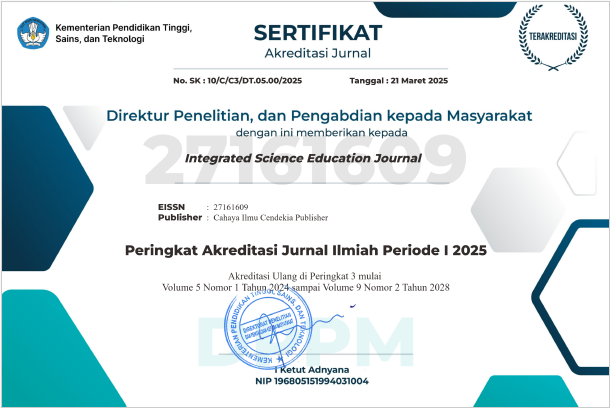Analysis of Driving Factors for the Implementation of Clean Technology to Optimize Green Manufacturing in the Wiradesa Batik Small and Medium Enterprises (SMEs)
Abstract
Purpose of the study: This research aims to improve green manufacturing in the batik SME environment. It must also improve clean technology.
Methodology: Give name, brand, type of tools, methods, software, review, and survey that has been used to do this study. No discussion or explanation.
Main Findings: The results of the study show that the highest weight is the need for a supply chain (F6) with a weight of 0.443, then the second most important factor is the good name factor of batik SMEs (F2) which is ranked second with a weight of 0.241. Next, the third most important factor is the internal motivation factor (F9) which is ranked third with a weight of 0.088. Followed by other factors until the least important factor is the competitor factor (F11) which is ranked seventh with a weight of 0.036.
Novelty/Originality of this study: what is new in this study that may benefit readers and how it is advancing the existing knowledge or creating new knowledge in this subject.
References
R. C. I. Prahmana and U. D’Ambrosio, “Learning geometry and values from patterns: Ethnomathematics on the batik patterns of yogyakarta, indonesia,” J. Math. Educ., vol. 11, no. 3, pp. 439–456, 2020, doi: 10.22342/jme.11.3.12949.439-456.
E. Sugiarto, M. I. Syarif, K. B. Mulyono, A. Nizam, and M. Krisnawati, “How is ethnopedagogy-based education implemented ? ( A case study on the heritage of batik in Indonesia ),” Cogent Educ., vol. 12, no. 1, p., 2025, doi: 10.1080/2331186X.2025.2466245.
S. O. Pela, N. N. Le, P. G. Kaboro, and A. Nurjamil, “Innovation of Physics E-Module : Utilizing Local Wisdom of Lampung ’ s Handwritten Batik in Teaching Heat and Temperature Material to Foster Students ’ Scientific Attitude,” vol. 4, no. 4, pp. 132–138, 2023, doi: 10.37251/sjpe.v4i4.924.
A. M. Aljeboree et al., “Direct Dyes Derived from 4 , 4 -Diaminobenzanilide Synthesis , Characterization and Toxicity Evaluation of a Disazo Symmetric Direct Dye,” Bioresour. Technol., vol. 2, no. 3, pp. 1–12, 2014, [Online]. Available: http://www.septic.umn.edu/prod/groups/cfans/@pub/@cfans/@ostp/documents/asset/cfans_asset_131281.pdf%5Cnhttp://link.springer.com/10.1007/s12257-009-0199-4%5Cnhttp://linkinghub.elsevier.com/retrieve/pii/S1876610214007504%5Cnhttp://dx.doi.org/10.1016/j.fct.2011.12.0
R. Legino, N. Zuhir, M. A. Samin, and S. Suminto, “A Comparison of the Motifs on Kuala Terengganu Block Batik Sarong,” Environ. Proc. J., vol. 8, no. SI16, pp. 85–89, 2023, doi: 10.21834/e-bpj.v8isi16.5225.
R. Oktavia, L. Wihastuti, and A. Nurpita, “Comparative study of fashion and convection smis in Yogyakarta, Solo, and Pekalongan,” Rev. Manag. Entrep., vol. 4, no. 1, pp. 17–46, Apr. 2020, doi: 10.37715/rme.v4i1.1219.
I. Isdiana, M. A. Zaid, and S. Akhtar, “Satu suro ceremony tradition: Tahlilan in the perspective of islamic religious education,” J. Pendidik. Agama Islam Indones., vol. 5, no. 1, pp. 13–21, 2024, doi: 10.37251/jpaii.v5i1.906.
S. A. Anggita, M. A. Mahboob, and S. S. Bin Hussein, “Celebrating the Prophet’s Birthday: a Manifestation of the Character of Cooperation in Islamic Education,” J. Pendidik. Agama Islam Indones., vol. 5, no. 1, pp. 22–29, 2024, doi: 10.37251/jpaii.v5i1.907.
S. Bouchard, S. Gamache, and G. Abdulnour, “Operationalizing mass customization in manufacturing SMEs—A systematic literature review,” Sustain., vol. 15, no. 4, 2023, doi: 10.3390/su15043028.
V. Gupta, “An empirical evaluation of a generative artificial intelligence technology adoption model from entrepreneurs’ perspectives,” Systems, vol. 12, no. 3, 2024, doi: 10.3390/systems12030103.
A. Ollerenshaw, J. Corbett, and H. Thompson, “Increasing the digital literacy skills of regional SMEs through high-speed broadband access,” Small Enterp. Res., vol. 28, no. 2, pp. 115–133, 2021, doi: 10.1080/13215906.2021.1919913.
S. I. Syed Shaharuddin et al., “A Review on the Malaysian and Indonesian Batik Production, Challenges, and Innovations in the 21st Century,” Sage Open, vol. 11, no. 3, p. 55, Jul. 2021, doi: 10.1177/21582440211040128.
S. Bin Silah, B. Isa, P. Ponimin, and T. Karyono, “Malaysian and Indonesian batik: The best practices,” KnE Soc. Sci., vol. 2021, pp. 47–55, 2021, doi: 10.18502/kss.v5i6.9177.
F. A. Phang, A. N. Roslan, Z. A. Zakaria, M. A. A. Zaini, J. Pusppanathan, and C. A. Talib, “Environmental awareness in batik making process,” Sustainability, vol. 14, no. 10, p. 6094, May 2022, doi: 10.3390/su14106094.
S. Rismantojo, V. Sirivesmas, E. Joneurairatana, and W. A. Natalia, “Transforming the Batik Tiga Negeri (Three-Countries Batik) in pleats to represent indonesia, malaysia, and thailand’s batik heritage by applying the ATUMICS Method,” Arch. Des. Res., vol. 37, no. 4, pp. 65–96, Aug. 2024, doi: 10.15187/adr.2024.08.37.4.65.
S. I. Syed Shaharuddin et al., “A review on the Malaysian and Indonesian batik production, challenges, and innovations in the 21st century,” Sage Open, vol. 11, no. 3, pp. 118–138, Jul. 2021, doi: 10.1177/21582440211040128.
I. Hermawan and A. Suwondo, “Making of Stamped Batik by Machined Batik Stamp Pattern Made from Hand Made Design Batik Image,” Int. J. Innov. Res. Adv. Eng., vol. 3, no. 03, pp. 2014–2017, 2016, [Online]. Available: http://www.ijirae.com/volumes/Vol3/iss3/05.MRAE10088.pdf
I. Wijayanti, T. Surti, A. D. Anggo, and E. Susanto, “Effect Different Packaging on Proximate and Lysine Content of Milkfish [Chanos Chanos (Forsskål, 1775)] Floss During Storage,” Aquat. Procedia, vol. 7, pp. 118–124, 2016, doi: 10.1016/j.aqpro.2016.07.016.
L. von Kotzebue et al., “The framework dikolan (Digital competencies for teaching in science education) as basis for the self-assessment tool dikolan-grid,” Educ. Sci., vol. 11, no. 12, p. 775, Nov. 2021, doi: 10.3390/educsci11120775.
Z. J. Yong, W. J. Lin, S. C. Hsieh, and H. J. Lin, “Comparison of carbon budgets and greenhouse gas fluxes in monoculture ponds with milkfish (Chanos chanos) and Taiwanese hard clams (Meretrix taiwanica),” Aquac. Reports, vol. 43, no. January, 2025, doi: 10.1016/j.aqrep.2025.102924.
L. Indrayani and M. Triwiswara, “The implementation of green industry standard batik industry to develop eco-friendly,” IOP Conf. Ser. Mater. Sci. Eng., vol. 980, no. 1, p. 012081, Dec. 2020, doi: 10.1088/1757-899X/980/1/012081.
L. A. Mukadar, T. Joko, and O. Setiani, “Liquid waste pollution load analysis home industry batik and the impact on the quality of river water in the Sub-District of Pekalongan Selatan, Pekalongan City,” Int. J. Heal. Educ. Soc., vol. 4, no. 11, pp. 47–60, 2021, [Online]. Available: www.ijhes.com
N. M. D. Resiani and I. W. Sunanjaya, “The Efficiency of Water in Supporting Local Wisdom and Food Sustainability in Subak Sange, Bali Indonesia,” Agromet, 2020, doi: 10.29244/j.agromet.34.2.67-74.
M. Hussain et al., “Effect of varying dietary protein levels on growth performance and survival of milkfish Chanos chanos fingerlings reared in brackish water pond ecosystem,” Egypt. J. Aquat. Res., vol. 47, no. 3, pp. 329–334, 2021, doi: 10.1016/j.ejar.2021.05.001.
D. T. Amijaya, S. Komariah, K. P. Putri, and M. C. Devi, “Multiple regression: Deteminant on profitability at islamic commercial banks in Indonesia,” Dinasti Int. J. Econ. Financ. Account., vol. 1, no. 1, pp. 21–30, 2020, doi: 10.38035/DIJEFA.
N. Tor and G. Gordon, “Digital interactive quantitative curiosity assessment tool: Questions worlds,” Int. J. Inf. Educ. Technol., vol. 10, no. 8, pp. 614–621, 2020, doi: 10.18178/ijiet.2020.10.8.1433.
L. SÜRÜCÜ and A. MASLAKÇI, “Validity and Reliability in Quantitative Research,” Bus. Manag. Stud. An Int. J., vol. 8, no. 3, pp. 2694–2726, 2020, doi: 10.15295/bmij.v8i3.1540.
O. D. Apuke, “Quantitative Research Methods : A Synopsis Approach,” Kuwait Chapter Arab. J. Bus. Manag. Rev., vol. 6, no. 11, pp. 40–47, 2017, doi: 10.12816/0040336.
J. W. Creswell and J. D. Creswell, Research design: qualitative, quantitative, and mixed methods approaches, 4th Editio. Newbury Park: Sage publications, 2017.
L. Yao, S. Haberman, D. F. McCaffrey, and J. R. Lockwood, “Large-Sample Properties of Minimum Discriminant Information Adjustment Estimates Under Complex Sampling Designs,” ETS Res. Rep. Ser., vol. 2020, no. 1, pp. 1–20, 2020, doi: 10.1002/ets2.12297.
M. A. Adeoye, “Review of Sampling Techniques for Education,” ASEAN J. Sci. Educ., vol. 2, no. 2, pp. 87–94, 2023.
S. K. Fianko, T. C. Dzogbewu, and E. Agbamava, “Mass Customisation Strategies in Additive Manufacturing : A Systematic Review and Implementation Framework,” pp. 1–42, 2025.
F. K. Şemin, “Competencies of principals in ensuring sustainable education: Teachers’ views,” Int. J. Eval. Res. Educ., vol. 8, no. 2, pp. 201–212, 2019, doi: 10.11591/ijere.v8i2.18273.
C. Ai Tran, D. H. Van, T. Thuy Phuong Nguyen, T. Thi Thanh Nguyen, and T. Minh Nguyen, “Research in higher education quality assurance worldwide (2003–2023): a bibliometric analysis from the Scopus database,” Cogent Educ., vol. 12, no. 1, p., 2025, doi: 10.1080/2331186X.2025.2479405.
M. Jingjit, “The Effects of multimedia learning on Thai primary pupils’ achievement in size and depth of vocabulary knowledge,” J. Educ. Pract., vol. 6, no. 32, pp. 72–81, 2015.
S. Ghavifekr and W. A. W. Rosdy, “Teaching and learning with technology: Effectiveness of ICT integration in schools,” Int. J. Res. Educ. Sci., vol. 1, no. 2, pp. 175–191, 2015, doi: 10.21890/ijres.23596.
S. Sousa, E. Correia, J. Leite, and C. Viseu, “Environmental knowledge, attitudes and behavior of higher education students: a case study in Portugal,” Int. Res. Geogr. Environ. Educ., vol. 0, no. 0, pp. 1–18, 2020, doi: 10.1080/10382046.2020.1838122.
L. Verschaffel, S. Schukajlow, J. Star, and W. Van Dooren, “Word problems in mathematics education: a survey,” ZDM - Math. Educ., vol. 52, no. 1, pp. 1–16, 2020, doi: 10.1007/s11858-020-01130-4.
A. Xu and L. Ye, “Impacts of teachers’ competency on job performance in research universities with industry characteristics: Taking academic atmosphere as moderator,” J. Ind. Eng. Manag., vol. 7, no. 5, pp. 1283–1292, 2014, doi: 10.3926/jiem.1261.
E. Muslimah, M. Anis, and M. Djunaidi, “The impact of using raw materials and batik industry waste on the environment,” in 1st Virtual Workshop on Writing Scientific Article for International Publication Indexed SCOPUS, Sciendo, 2022, pp. 428–433. doi: 10.2478/9788366675827-075.
A. Stancu and M. Panait, “Marketing strategy metamorphosis under the impact of artificial intelligence services,” Systems, vol. 13, no. 4, pp. 1–25, 2025, doi: 10.3390/systems13040227.
Copyright (c) 2025 Muhammad Slamet Rahajo, Achana Kumyat

This work is licensed under a Creative Commons Attribution 4.0 International License.
Authors who publish with this journal agree to the following terms:
- Authors retain copyright and acknowledge that the Integrated Science Education Journal is the first publisher licensed under a Creative Commons Attribution 4.0 International License.
- Authors are able to enter into separate, additional contractual arrangements for the non-exclusive distribution of the journal's published version of the work (e.g., post it to an institutional repository or publish it in a book), with an acknowledgment of its initial publication in this journal.
- Authors are permitted and encouraged to post their work online (e.g., in institutional repositories or on their website) prior to and during the submission process, as it can lead to productive exchanges and earlier and greater citation of published work.







.png)
.png)






